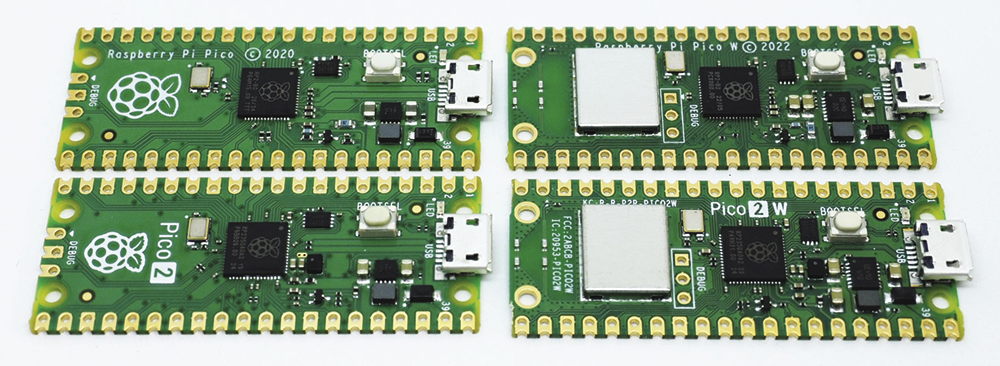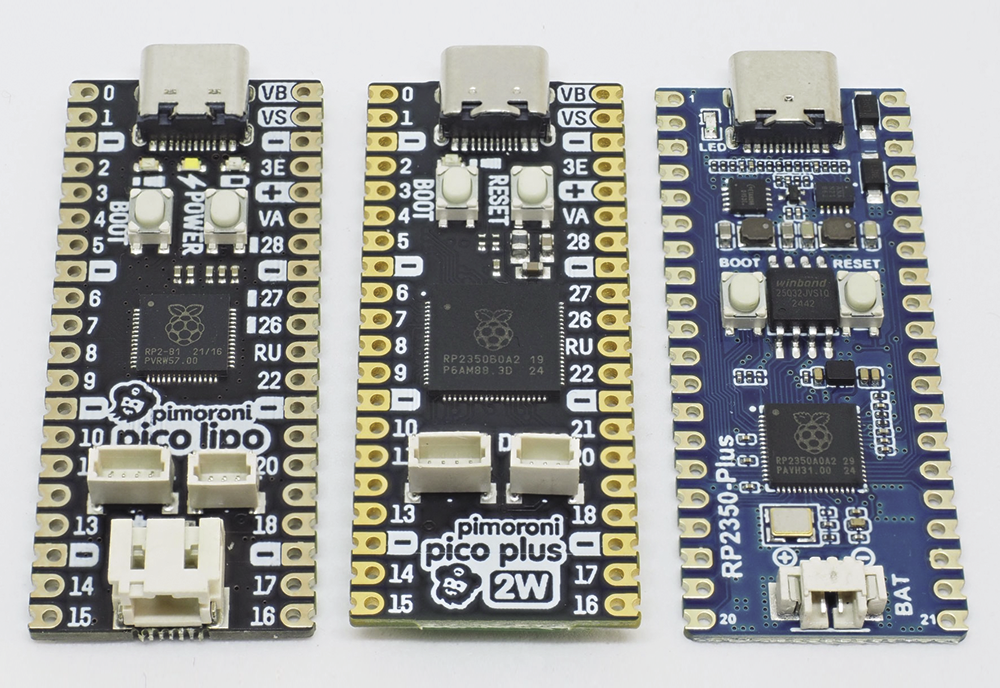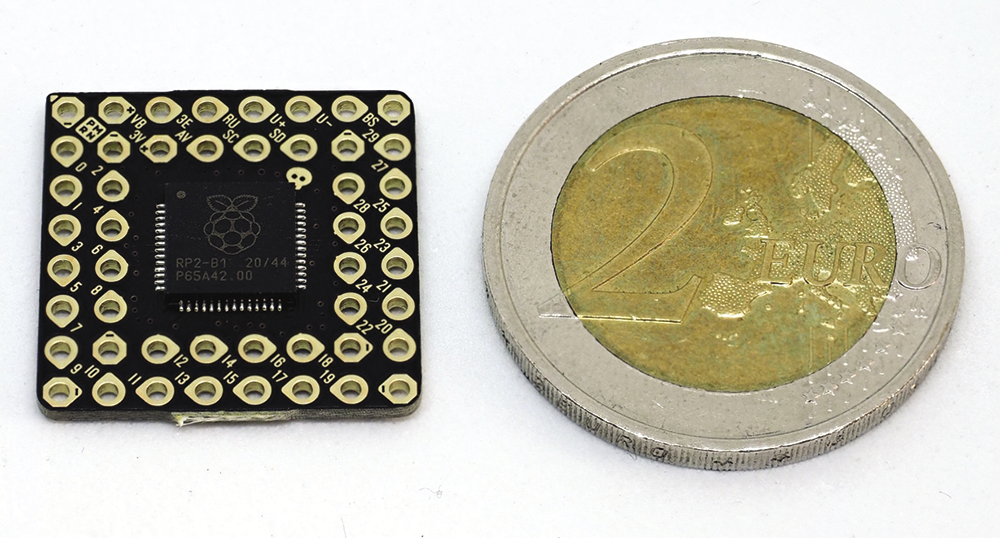Pico Pi Parade
The Pi Pico chips are pretty cheap, which has made them hugely popular with hobbyists. This overview helps you decide which of these tiny computers to pick for your project.
Makers are delighted with the huge selection of miniature boards, as this gives them access to a broad range of different breakouts. The processor is the most important selection criterion. Although Raspberry Pi’s RP2040 is no longer new, it is cheaper than its successor, the RP2350, and the RP2040’s speed and memory are fine for many requirements.
The main memory goes hand in hand with the processor. The RP2040 has a standard 256KB, while the RP2350 has at least 520KB. The newer MCU lets you supplement the built-in RAM with external Pseudostatic RAM (PSRAM), whose content is volatile and is lost when the operating voltage is switched off. Although PSRAM is slower than the main memory, it’s still far faster than flash. That is why there are also RP2350 boards with an additional 8MB main memory.
This ability proves particularly useful when you need to process large volumes of data, such as those associated with large displays. The other part of the memory, the flash memory, is used to store programs and other data, especially media. Audio and video files in particular can quickly use up the 2MB, but even the maximum possible 16MB does not give you massive scope.
The size of the circuit board is also one of the selection criteria. Not all projects have enough space for the 52x21mm that a Pico measures. However, smaller circuit boards have fewer pins. This is something to take into account when you make your choice. Even variants that appear to be the same size, and supposedly compatible, at first glance are not necessarily identical. A millimeter here or there can cause problems with some housings.
Another important but often overlooked detail is that all of the boards have a voltage converter. Not every board can handle the same input voltage. The converters not only supply the internally required power at the correct amperage, but also the current for peripheral devices via the 3V3 pin. The power limit can often only be determined after studying circuit diagrams and data sheets, as manufacturers prefer to advertise the generous memory capacity rather than potentially undersized voltage converters. Table 1 shows a small selection of current boards from the RP2xxx series, without any claim to completeness.
Table 1: RP2xxx Boards at a Glance
|
Name |
Manufacturer |
Price |
Processor |
RAM |
PSRAM |
Flash |
Pins |
Dimensions |
Power Consumption |
Special Features |
|
RP2040 |
|
|
|
|
|
|
|
|
|
|
|
Pi Pico |
Raspberry Pi Foundation |
EUR4.10 |
RP2040 |
264KB |
– |
2MB |
26/40 |
51 x 21 x 4 |
300mA |
– |
|
Pi Pico W |
Raspberry Pi Foundation |
EUR6.70 |
RP2040 |
264KB |
– |
2MB |
26/40 |
51 x 21 x 4 |
300mA |
With CWY4343x for WLAN/Bluetooth |
|
Tiny 2040 2MB |
Pimoroni |
EUR9.20 |
RP2040 |
264KB |
– |
2MB |
12/16 |
22.9 x 18.2 x 6 |
300mA |
RGB LED, RST, USR, USB-C |
|
XIAO RP2040 |
Seeed Studio |
EUR6.30 |
RP2040 |
264KB |
– |
2MB |
11/14 |
21 x 17.8 x 4.4 |
500mA |
Stemma QT, RST, RGB LED, USB-C |
|
RP2040-Zero |
Waveshare |
EUR4.50 |
RP2040 |
264KB |
– |
2MB |
20/23 |
23.5 x 18 x 5.5 |
500mA |
RST, 9 additional pins via solder points, no VSYS pin, USB-C |
|
RP2040-Zero (clone) |
Unknown |
EUR1.70 |
RP2040 |
264KB |
– |
2MB |
20/23 |
23.5 x 18 x 5.5 |
Unknown |
RST, 9 additional pins via solder points, no VSYS pin |
|
RP2040 Super Mini |
eElectronicParts |
EUR2.85 |
RP2040 |
264KB |
– |
2MB |
20/23 |
23.5 x 18 x 4.6 |
Unknown |
9 additional pins via solder points, no VSYS pin, USB-C |
|
Pico LiPo 4MB |
Pimoroni |
EUR14.30 |
RP2040 |
264KB |
– |
4MB |
26/40 |
53 x 21 x 8 |
300mA |
Stemma QT, Charger (215mA), RST, USR, USB-C |
|
Tiny 2040 8MB |
Pimoroni |
EUR15.50 |
RP2040 |
264KB |
– |
8MB |
12/16 |
22.9 x 18.2 x 6 |
300mA |
RGB LED, RST, USR, USB-C |
|
QT Py RP2040 |
Adafruit |
EUR10.50 |
RP2040 |
264KB |
– |
8MB |
11/14 |
21 x 17.8 x 5.9 |
600mA |
Stemma QT, RST, NeoPixel, USB-C |
|
Pico LiPo 16MB |
Pimoroni |
EUR16.30 |
RP2040 |
264KB |
– |
16MB |
26/40 |
53 x 21 x 8 |
300mA |
Stemma QT, Charger (215mA), RST, USR, USB-C |
|
YD-RP2040 16MB |
VCC-GND Studio |
EUR2.50 |
RP2040 |
264KB |
– |
16MB |
26/40 |
53.4 x 23 x 5 |
Unknown |
RST, USR, USB-C, NeoPixel, no EN |
|
ProMicro RP2040 16MB |
Huanging |
EUR3.89 |
RP2040 |
264KB |
– |
16MB |
26/31 |
33 x 17.8 x 3.6 |
Unknown |
RST, confusing pin-out, USB-C |
|
RP2350 |
|
|
|
|
|
|
|
|
|
|
|
Pi Pico 2 |
Raspberry Pi Foundation |
EUR5.50 |
RP2350 |
520KB |
– |
4MB |
26/40 |
52.3 x 21 x 4 |
300mA |
– |
|
Pi Pico 2W |
Raspberry Pi Foundation |
EUR7.90 |
RP2350 |
520KB |
– |
4MB |
26/40 |
52.3 x 21 x 4 |
300mA |
With CWY4343x for WiFi/Bluetooth |
|
Tiny 2350 |
Pimoroni |
EUR9.50 |
RP2350 |
520KB |
– |
4MB |
12/16 |
22.9 x 18 x 5.8 |
300mA |
Stemma QT, RGB LED, RST, USR, USB-C |
|
RP2350-Zero |
Waveshare |
EUR5.50 |
RP2350 |
520KB |
– |
4MB |
20/23 |
23.5 x 18 x 5.5 |
800mA |
RST, 9 additional pins via solder points, no VSYS pin, USB-C |
|
RP2350-Plus 4 MB |
Waveshare |
EUR5.90 |
RP2350 |
520KB |
– |
4MB |
26/40 |
51 x 21 x 4.7 |
2000mA |
RST, charger (1000mA), LiPo connection, USB-C |
|
RP2350-Plus 16 MB |
Waveshare |
EUR6.90 |
RP2350 |
520KB |
– |
16MB |
26/40 |
51 x 21 x 4.7 |
2000mA |
RST, charger (1,000mA), LiPo connector, USB-C |
|
Pico Plus 2 |
Pimoroni |
EUR5.50 |
RP2350 |
520KB |
8MB |
16MB |
31/48 |
53 x 21 x 9 |
600mA |
Stemma QT, RST, USR, USB-C |
|
Pico Plus 2 W |
Pimoroni |
EUR22.50 |
RP2350 |
520KB |
8MB |
16MB |
31/48 |
53 x 21 x 9 |
600mA |
Stemma QT, RST, USR, CWY4343x, USB-C |
|
PGA2350 |
Pimoroni |
EUR10.60 |
RP2350 |
520KB |
8MB |
16MB |
48/60 |
25.4 x 25.4 x 3.6 |
300mA |
Provides all pins |
RST = Reset button; USR = User button (function user-definable) |
The Originals
Inexpensive but minimalist: That’s how the original boards from the Raspberry Pi Foundation can be described (Figure 1). They don’t even have a reset button; they only have the absolute minimum amount of memory, and even the voltage converter only gives you the recommended minimum of 300mA.

There are currently four variants: Pico, Pico W, Pico 2, and Pico 2W. The first two work with the first-generation chip, while the Pico 2 series boards use the RP2350. The W variants use a WLAN chip from Infineon for communication. With a form factor of 51x21mm and 2x20 pins, the Raspberry Pi Foundation has set the standard around which a large ecosystem of HATs, packs, and other add-on boards have developed.
Even though features are limited, beginners or those in the very early stages of a project should opt for the original boards. Despite their low price, the quality is excellent, and there are many examples to help with projects. In case of problems, the community is there to help – an advantage that should not be underestimated.
Big Guns
If you need more flash or RAM memory, go for one of the boards that are typically far better equipped in other respects, too. The dimensions are not necessarily larger. Well-known suppliers include Adafruit, Waveshare, and Pimoroni (Figure 2). Pimoroni boards, for example, feature reset buttons and a Stemma QT connector for I2C peripherals. The first generation of this series, known as the Pico Plus, also offered a LiPo connector for charging electronics. Of course, all these extras raise the prices.

The alternatives are never fully compatible with the originals. For example, you can solder a Pi Pico flat onto a carrier board, whereas some of the better-equipped variants are double-sided. When it comes to voltage input, even the original Picos impress: They will keep on running down to a minimum power of 1.8V, which is about what you get from two almost flat AA batteries. The voltage converters of the Pimoroni and Waveshare MCUs, on the other hand, require at least 3.3V. Having said this, Waveshare offers a voltage converter in its Plus models that nominally delivers 2A. Whether the other internal electronics can actually handle this remains to be seen.
Little Ones
Smaller versions with fewer pins are also available from various manufacturers (Figure 3). These boards are usually shorter and offer only half as many pins. However, they also cost more than the originals, as their more compact layout makes them more complex to manufacture.

The boards in the XIAO form factor (Adafruit refers to this as QT Py) defined by manufacturer Seeed Studio are particularly interesting. There are many add-ons available for this mini format, allowing small projects to be implemented quickly. The RP2040-Zero by Waveshare has a large number of pins, but when fully equipped it is no longer breadboard-compatible. I recommend purchasing the unpopulated version and routing the additional pins upwards at the end of the board.
Family and Friends
The Chinese are considered masters of copying, and so there are many Pico clones on the usual marketplaces. Even China-based Waveshare has to contend with replicas, such as the clone on the far left in Figure 4, that border on plagiarism. However, since projects now usually publish the circuit diagrams of their boards, this is not a major problem. A cloned RP2040-Zero that looks almost identical to the Waveshare version is available for an unbeatable EUR1.70 ($2 or £1.50). This gives rise to the suspicion that the supplier could be cutting corners on some components.

It doesn’t make sense to demonize everything that comes out of China. I have also found a number of designs that offer good approaches. The original Picos, for example, do not protect the VBUS pin against feedback. Even with USB and simultaneous battery power, you have to take care of the necessary protections for the battery yourself. In contrast, the YD-RP2040 (Figure 4, center right) comes with the appropriate diodes in place.
For the usual quantities required by a private maker, it doesn’t make much sense to buy in China just so that you can save a few cents. If you need large quantities, you might prefer to rely on a reliable delivery partner anyway. In addition, anyone buying directly in China needs to be well informed and capable of reading and understanding circuit diagrams and data sheets, as important information is often not even found in the small print.
The Specialists
Specialized circuit boards offer another alternative to Pico boards. Pimoroni and Solder Party, for example, supply PCBs that are barely larger than a postage stamp (Figure 5). They can be integrated into your own circuit boards to create customized boards without having to master the challenges of complete electronics support, including circuit board layout.

Boards with a different processor, but with the format and pinout of a Pi Pico, are yet another type of special-purpose board. Waveshare, for example, offers the ESP32-S3-Pico, which I have used as a pin-compatible RP2040 replacement in various projects. The advantages of the Waveshare board are more RAM and more flash, and it also offers many interesting features. When compared with the RP2350, the memory size differences are no longer that big, but in terms of price, the ESP32-S3-Pico is a very appealing choice given its performance.
For this overview, I’ve left out all RP2xxx boards that come with additional peripherals such as a LoRa chip or a screen. There are many of those as well, from tiny OLEDs to large e-ink displays with 800x400 pixels. However, such combinations tend to focus more on the additional components than on the basics. Because there is no wiring, they offer compact design options for your projects. In most cases, though, you have to accept other compromises, because the boards have no free pins or only a few, for example.
Conclusions
The choice of RP2xxx-compatible boards is huge, so there should be something to suit everyone. Even if money is no object, the more opulently equipped products are not necessarily a better choice than the originals from the Raspberry Pi Foundation. You don’t have to be a clairvoyant to predict that the future will bring even more variants. This is mainly because the Raspberry Pi Foundation now also sells the Pico W’s WiFi chip as a separate product, which enables third-party providers to launch software-compatible solutions with RP2xxx and WiFi on the markets. It is worth checking back from time to time to see what new developments manufacturers have to offer.


